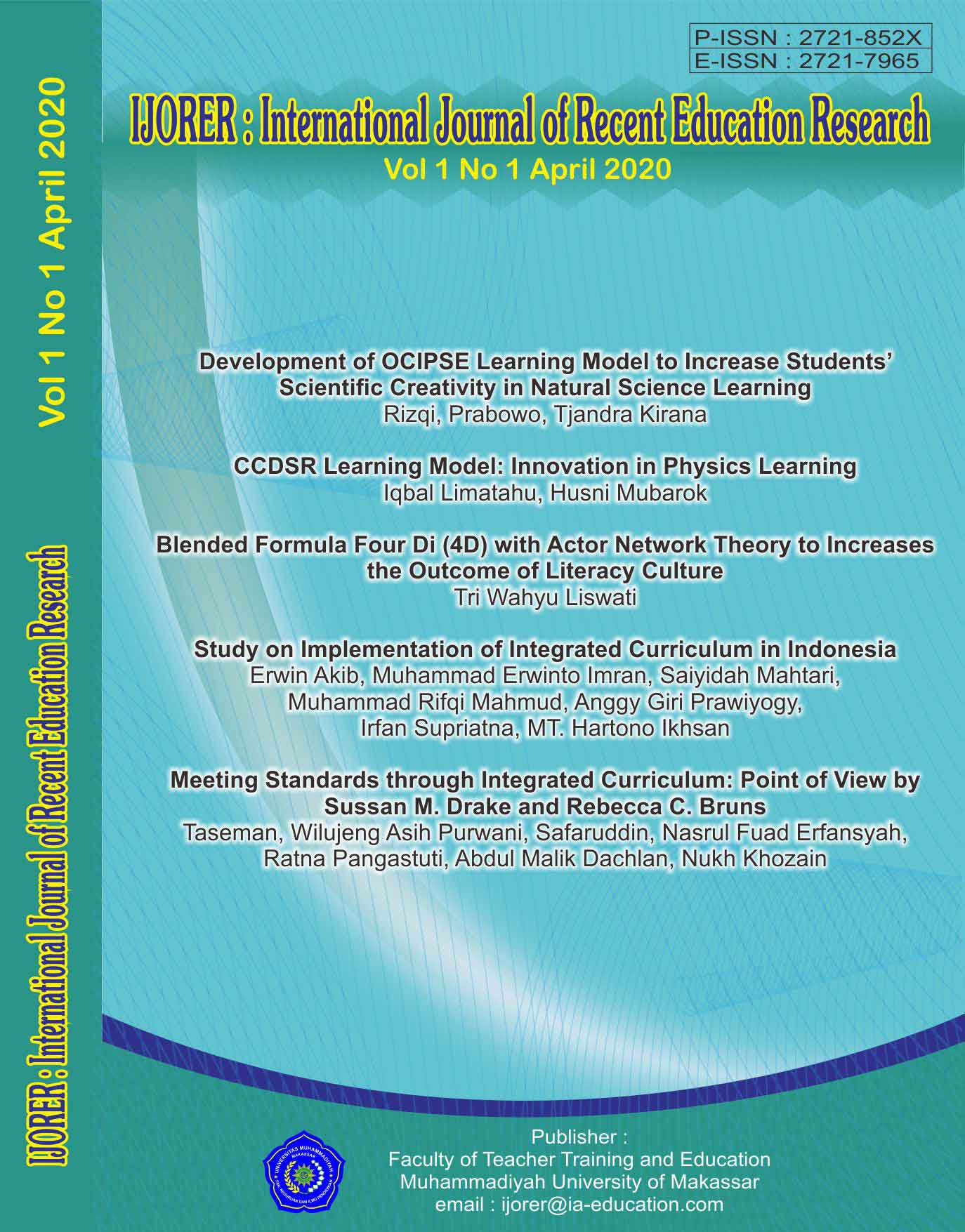Blended Formula Four Di (4D) with Actor Network Theory to Increases the Outcome of Literacy Culture
Abstract
The purpose of this research is to evaluate the effectiveness of the Blended Formula Four Di (4D) with Actor Network Theory in increasing the outcome of literacy culture is a case study that involves all school members. The obtained data were analysed by using qualitative descriptive methods. The analysis results inform that the Blended Formula Four Di (4D) with Actor Network Theory has proven to be effective in improving the outcome of literacy culture in schools. The application of "Blended Formula Four Di (4D) with Actor Network Theory to Increases The Outcome of Literacy Culture" is also able to improve literacy culture in SMAN 1 Ngimbang with indicators (1) increasing the number of visitors and borrowers in the library, (2) increasing the writing of the school residents, and (3) becoming the winner of the library competition.
 PDF Download: 421
PDF Download: 421
References
Baleiro, R. (2011). A definition of literacy: A content analysis of literacy of literatur syllabuses and interviews with portuguese lecturers of literature. Journal of New Horizons in Education, 1(4), 16-25.
Depdikbud. (2015). Peraturan menteri pendidikan dan kebudayaan nomor 23 tahun 2015 tentang penumbuhan budi pekerti. Jakarta: Kemendikbud.
Gaske, A., & Ozola, A. (2008). Factors influencing reading literacy at the primary school level. Problems of Education in the 21st Century, 6(1), 71-77.
Gong, A.G., & Irkham, M.A. (2012). Gempa literasi. Jakarta: Kepustakaan Gramedia Populer.
Ibda, H. (2018). Penguatan literasi baru pada guru madrasah ibtidaiyah dalam menjawab tantangan era revolusi industri 4.0. JRTIE: Journal of Research and Thought of Islamic Education, I, 1–21.
Ibda, H. (2019). Pembelajaran bahasa indonesia berwawasan literasi baru di perguruan tinggi dalam menjawab tantangan era revolusi industri 4.0. Jalabahasa, 15(1), 48-64.
Indriyani, V., Zaim, M., Atmazaki, & Ramadhan, S., (2019). Literasi baca tulis dan inovasi kurikulum bahasa. Jurnal Keilmuan Bahasa, Sastra, dan Pengajarannya. 5(1), 108-118.
Jane, W. (2012). The role of out-of-school factors in the literacy problem. The Future of Children, 22(2), 40-54.
Mills, K. (2010). A review of the digital turn in the new literacy studies. Review of Educational Research, 80(2), 246–271.
Musfiroh, T. & Beniati, L. (2016). Konstruk kompetensi literasi untuk siswa sekolah dasar. LITERA, 15(1), 1-12
Muslimin. (2018). Foster a culture of literacy through increased reading interest in village communities. Cakrawala Pendidikan, 37(1), 107-118.
Nurdiyanti, E., & Suryanto, E. (2010). Pembelajaran literasi mata pelajaran bahasa indonesia pada siswa kelas V sekolah dasar. Jurnal PAEDAGOGIA, 13(2), 115-128.
Nurgiantoro, B. (2005). Tahapan perkembangan anak dan pemilihan bacaan sastra anak. Cakrawala Pendidikan, 26(2), 197-216.
Odegaard, M., Haug, B., Mork, S., & Sorvik, G.O. (2014). Budding science and literacy. A classroom video study of the challenges and support in an integrated inquiry and literacy teaching model. Procedia-Social and Behavioral Sciences, 167, 274-278.
Shofa, M.F., & Setyawan, H.Y. (2018). Literacy culture strengthening programs to stimulate reading interest for children at early age. Early Childhood Education Program, 1(1), 8-20.
Stephen, B.K., (2015). Literacy: Varied, dynamic, and multidimensional. Journal of Family Strenghts, 15(2), 1-35.
Suryaman, M. (2015). Analisis hasil belajar peserta didik dalam literasi membaca melalui studi internasional (PIRLS) 2011. Jurnal LITERA, 14(1), 170-186.
Wandasari, Y. (2017). Implementasi gerakan literasi sekolah (GLS) sebagai pembentuk pendidikan karakter. Jurnal Manajemen, Kepemimpinan, dan Supervisi Pendidikan, 1(1), 325-342.
Wiedarti, P., & Kisyani, L. (2016). Desain induk gerakan literasi sekolah. Jakarta: Dikdasmen, Kemdikbud.
Yuliyati. (2014). Model budaya baca-tulis berbasis balance literacy dan gerakan informasi literasi di SD. Jurnal Ilmu Pendidikan, 20(1), 117-126.
Copyright (c) 2020 IJORER : International Journal of Recent Educational Research

This work is licensed under a Creative Commons Attribution-ShareAlike 4.0 International License.
 PDF downloaded = 421 times
PDF downloaded = 421 times
































